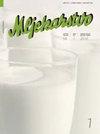The influence of different stress factors on the production and quality of sheep milk
IF 1.1
4区 农林科学
Q3 AGRICULTURE, DAIRY & ANIMAL SCIENCE
引用次数: 0
Abstract
Around 10.5 million tonnes of sheep milk are produced worldwide, and around 3.1 million tonnes in Europe. In Europe, sheep milk production has stagnated slightly in recent years and currently accounts for around 1/3 of the global production. Due to its high content of dry matter, milk fat, total protein and casein, sheep milk is an excellent raw material for cheese production. Milk processing and cheese making are not only economically important, but also part of the cultural heritage based on a long tradition, often taking place in rural and less developed areas. Milk production and quality are very complex and are influenced by numerous factors, the most important of which are breed, feeding and body condition, parity and stage of lactation, milking and udder health, and environmental factors. In addition, different types of stress such as heat stress, nutritional stress, weaning stress, shearing stress, stress of regrouping, etc. have a significant impact on the welfare and health of the sheep as well as on the quantity of milk produced, its chemical composition, processing characteristics and the economic efficiency of the flock. In recent years, due to climate change, there has been an increasing number of studies on the effects of heat stress on the reproductive and production characteristics of sheep, as well as on their welfare and health. In addition, heat stress is often associated to the feed and the lack of water. The effects of stress are particularly pronounced in extensive sheep farming and milk production, which are prevalent in sheep farming. The aim of this paper is to describe the effects of the main types of stress on the quantity and chemical composition of sheep milk and on animal welfare.不同应激因素对绵羊奶产量和质量的影响
全球绵羊奶产量约为 1050 万吨,欧洲约为 310 万吨。近年来,欧洲的绵羊奶产量略有停滞,目前约占全球产量的 1/3。由于绵羊奶的干物质、乳脂肪、总蛋白和酪蛋白含量高,因此是奶酪生产的绝佳原料。牛奶加工和奶酪制作不仅具有重要的经济意义,而且还是基于悠久传统的文化遗产的一部分,通常在农村和欠发达地区进行。牛奶的产量和质量非常复杂,受许多因素的影响,其中最重要的是品种、饲喂和体况、泌乳期的奇偶性和阶段、挤奶和乳房健康以及环境因素。此外,不同类型的应激,如热应激、营养应激、断奶应激、剪毛应激、集群应激等,对绵羊的福利和健康以及产奶量、其化学成分、加工特性和羊群的经济效益都有重大影响。近年来,由于气候变化,有关热应激对绵羊繁殖和生产特性以及对其福利和健康影响的研究越来越多。此外,热应激往往与饲料和缺水有关。在养羊业普遍存在的粗放式养羊和牛奶生产中,应激的影响尤为明显。本文旨在描述主要类型的应激对绵羊奶的数量和化学成分以及动物福利的影响。
本文章由计算机程序翻译,如有差异,请以英文原文为准。
求助全文
约1分钟内获得全文
求助全文
来源期刊

Mljekarstvo
Agricultural and Biological Sciences-Animal Science and Zoology
CiteScore
1.90
自引率
41.70%
发文量
18
审稿时长
12 weeks
期刊介绍:
Mljekarstvo is an open access, peer-reviewed international quarterly scientific journal. The first issue was published in 1951, by the Croatian Dairy Operators'' Association (today: Croatian Dairy Union, publisher). In a paper at a Union conference held 28 October 1951 in Zagreb it was said: "Our desire is that this magazine does not meet the fate of its predecessors, but that it continues to reflect the creative efforts and to provide guidelines for the producers as well as all other operators employed in the dairy industry."
It is our pleasure today to say that wishes of the enthusiasts who attended the conference have come true, and the magazine Mljekarstvo during the last six decades was a reflection of the creative efforts of numerous dairy scientists and experts, and through its texts it served as a guideline in improving production and processing of milk and dairy products. Mljekarstvo has been following all the achievements of the dairy profession in Croatia, and it also gives the short surveys of world achievements. The result of the research of local and foreign scientists and experts always find their place in the magazine Mljekarstvo. It has been edited by our outstanding dairy experts employed at colleges, research institutions and dairy companies.
 求助内容:
求助内容: 应助结果提醒方式:
应助结果提醒方式:


